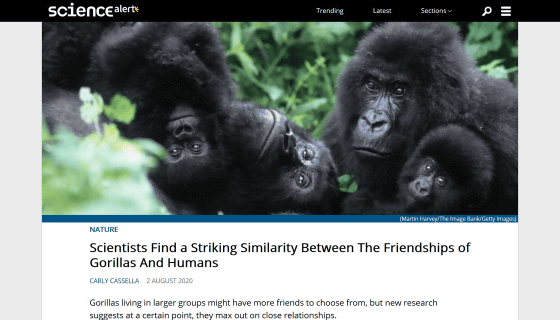Gorilla and human relationships have been found to be very similar, what are the common points?

by
It is said that up to 150 people can maintain a stable and smooth relationship, and such an 'upper limit of the number of people who can maintain a stable relationship with each other' is called the number of Dunbar . Even if it belongs to a social group with more people than Dunbar, it is said that the number of people with whom a person can have a close relationship will not increase, but this phenomenon is not limited to humans. The gorilla also found that 'even if the social group grows, it does not mean that the number of people with whom we have a close relationship does not increase.'
Comparing measures of social complexity: larger mountain gorilla groups do not have a greater diversity of relationships | Proceedings of the Royal Society B: Biological Sciences
https://royalsocietypublishing.org/doi/10.1098/rspb.2020.1026
Home page news-Gorilla relationships limited in large groups-University of Exeter
https://www.exeter.ac.uk/news/homepage/title_807504_en.html
Scientists Find a Striking Similarity Between The Friendships of Gorillas And Humans
https://www.sciencealert.com/there-sa-striking-similarity-between-the-friendships-of-gorillas-and-humans

The Dunbar number was proposed by anthropologist
In many cases, it is thought that the larger the population of a herd, the more complex the social life becomes. A team of researchers from the University of Exeter and the mountain gorilla conservation group, the Dian Fossey Gorilla Fund , tracked a herd of thirteen gorillas in Rwanda over a 12-year period, with a total of more than 150 mountain gorillas traveling, eating and drinking with each other. We measured the time spent on grooming.
Mountain gorillas generally live in groups of about 12 to 20, but their numbers fluctuate over time. In recent years, the number of gorillas that live in national parks has increased, and sometimes a group of as many as 65 individuals was formed.

In this survey, in order to measure the 'social relationship' between gorillas, we measured the 'time spent together' by each individual. Robin Morrison, an anthropologist and lead author of the paper, said, 'Most primates use 'time to groom each other' when measuring social relationships. But gorillas ``Since we spend less time grooming than primates, we measure social interaction in gorilla societies instead of grooming, by'who sits next to and who's away from?''' I am.
The research team measured how close each gorilla is to each other, and classified the familiarity among individuals into seven ranks. As a result, it was found that the variation in the relationship between individuals was the case when the number of individuals in the herd was 12 to 20. On the other hand, as the number of herds increased, many relationships became the 'weakest', and the variation in social relationships decreased.
It is unclear why the complexity of relationships decreases as the size of a social group increases, but Morrison says that the limit of 'time and mental energy to establish a strong relationship with a specific individual' is Pointed out that it may be related to the upper limit. The gorilla maintained strong relationships with a small number of people even as the social group grew larger, but since it spends time and mental energy there, it may have weak relationships with most other individuals. There seems to be 'Life in a social group requires mental effort,' Morrison said.

Lauren Brent, an associate professor at the University of Exeter, said, 'In addition to the fact that herds over a certain size did not have social diversity, they also differed in level among individuals living in the same herd. It had a social complexity.' It seems that some gorillas were more social than other gorillas and there were more close-knit individuals, as some human beings were especially sociable and broad-faced.
It was also found that male gorillas had a sharp decline in close relationships with adolescents, while female gorillas remained stable throughout their lives. In this regard, the research team speculates that male gorillas may be forced to make a choice 'whether they leave their herd' after puberty, which may lead to a reduction in relationships.
'This is evidence that not everyone in the group, humans or gorillas, is experiencing a similar social world,' Brent said.

From the results, the research team pointed out that 'the social complexity measured by the size of the herd may not reflect the social complexity experienced by each individual belonging to the herd'. .. He argued that if we wanted to understand relationships in primate herds, we needed to take a more comprehensive approach that goes beyond the size of social groups.
Related Posts:







